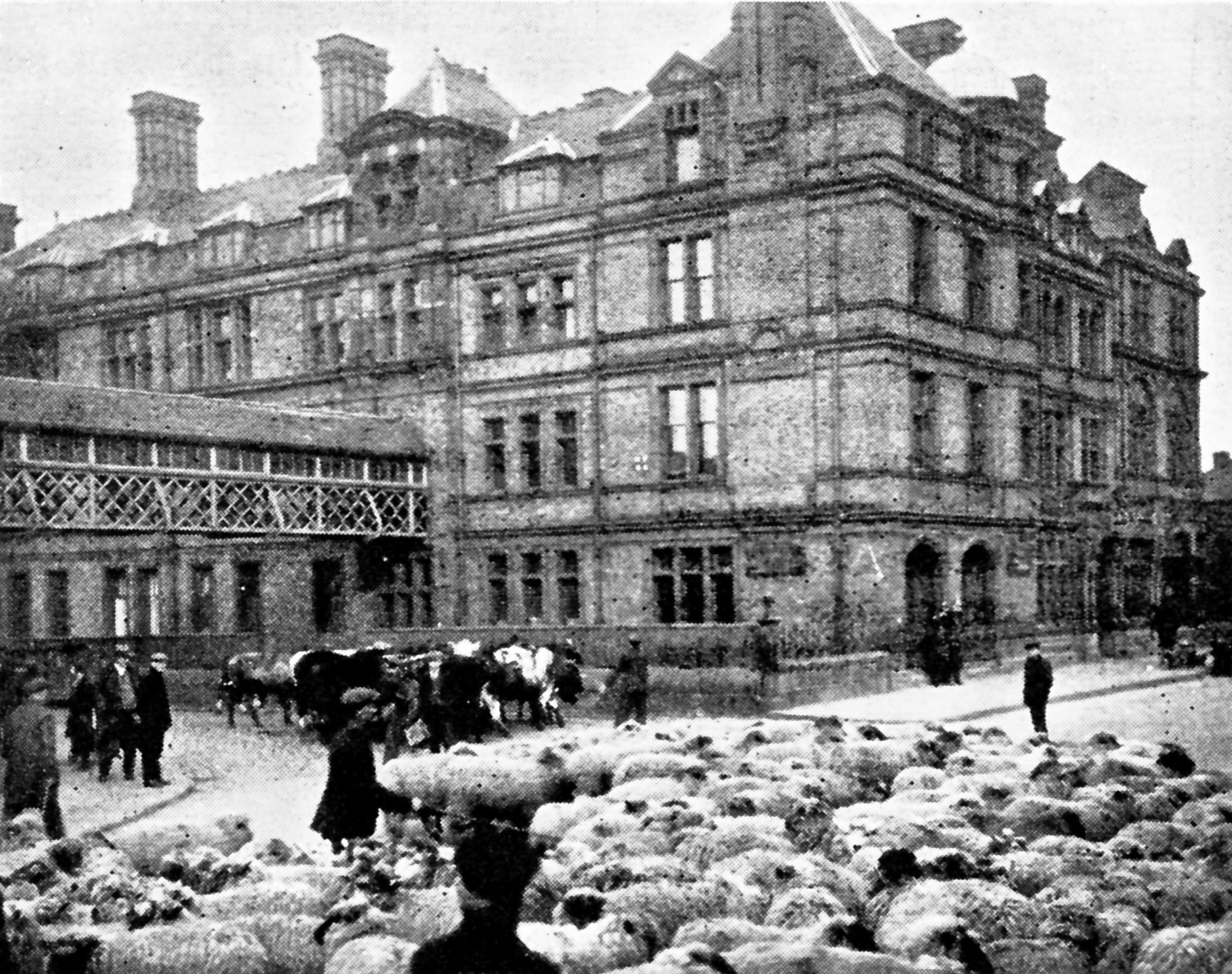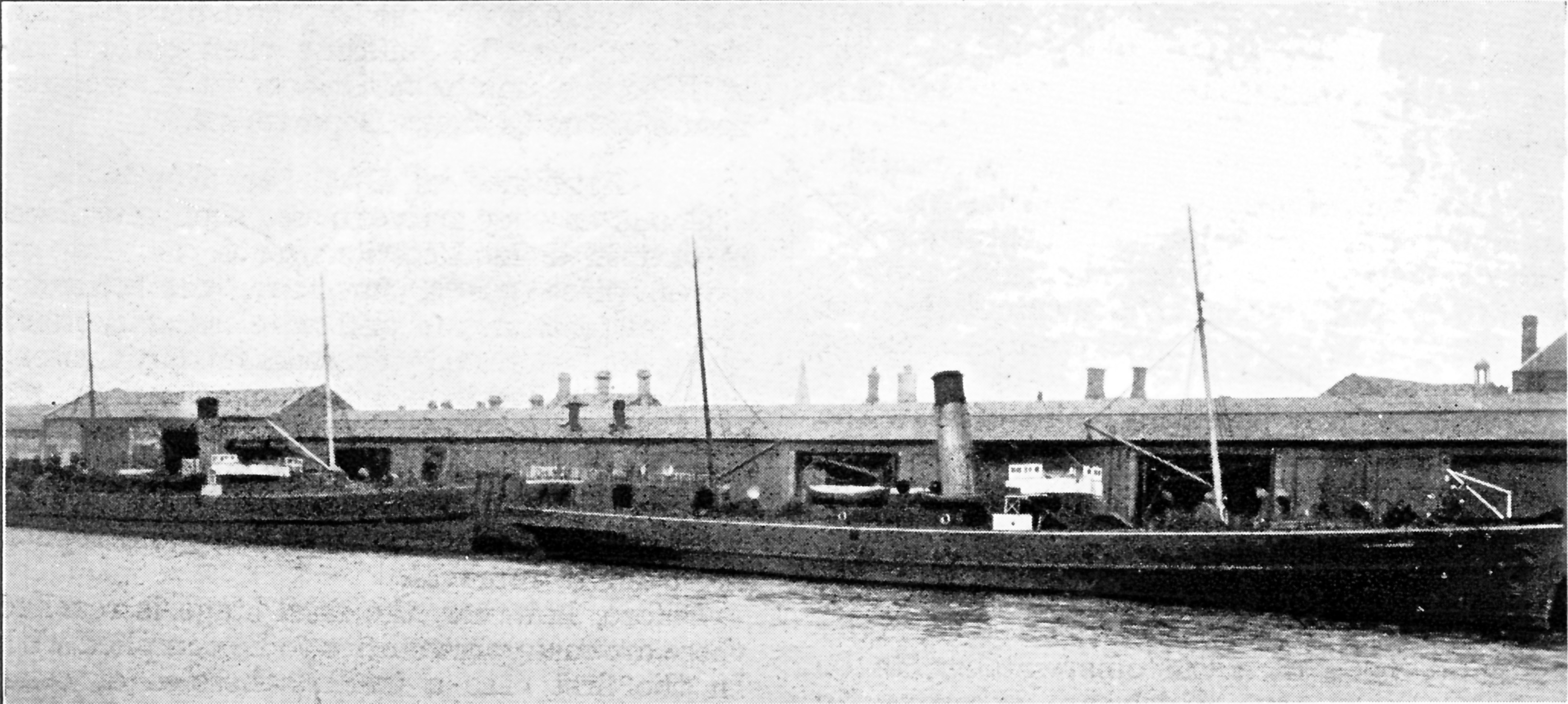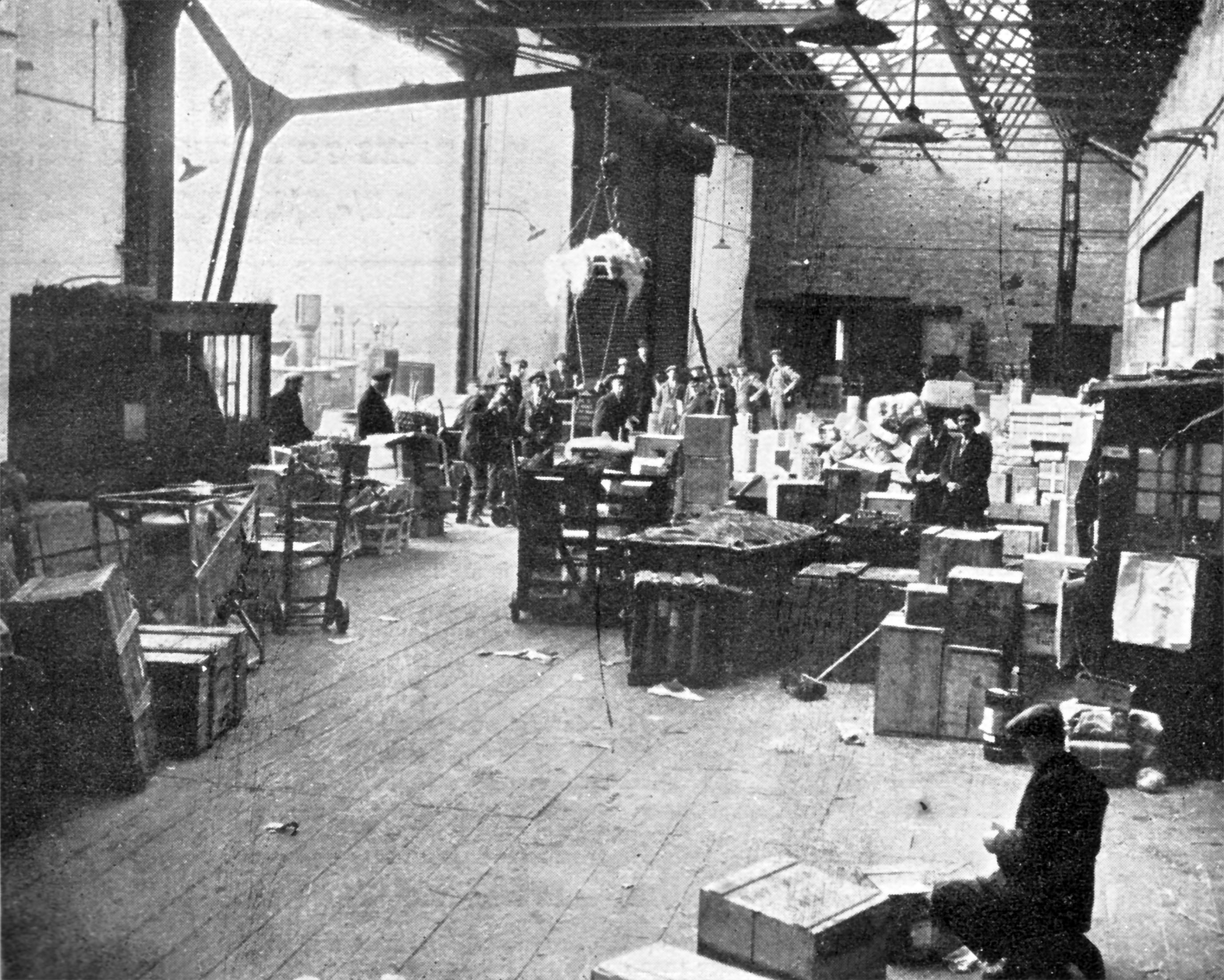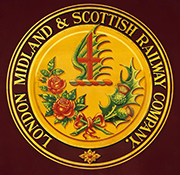

This site uses non-intrusive cookies to enable us to provide a better user experience for our visitors. No personal information is collected or stored from these cookies. The Society's policy is fully explained here. By continuing to use this site you are agreeing to the use of cookies.
[as reported in the April 1932 edition of the “in-house” LMS Magazine.]

LMS OFFICES (FORMERLY THE L. & N.W. HOTEL) AT NORTH WALL, SHOWING SHEEP, ETC., FOR SHIPMENT
THE year 1932 will be an interesting one for the Irish Free State. Already there is a new Government; the International Eucharistic Congress takes place in Dublin in June, and an Industrial and Agricultural Fair will be held in Cork during the summer months. As the year wears on it will bring, let us hope, increasing prosperity to the country. All this suggests a reason for writing something of LMS activities on the western side of the Irish sea.
The Company's headquarters in the Irish Free State are situated in Dublin, on the north side of the river Liffey, and comprise extensive offices, which now include the former hotel of the L. & N.W. Company, a redbrick building of some distinction; a transit shed stretching along the riverside for a distance of 1,225 ft.; a Customs warehouse for dutiabIe traffic, and cattle and railway yards in direct communication through the Great Southern and Great Northern railways with the Dublin termini and all parts of Ireland.
The LMS cross-channel steamship services to and from the Irish Free State are run between Holyhead and Dun Laoghaire (Kingstown), Dublin (North Wall), and Greenore; the two latter being for merchandise and livestock traffic, while the former is now the Royal Mail route, previously worked by the City of Dublin Steam Packet Company's steamers.
The work at Dublin (North Wall), which I shall deal with first, may be briefly described under three main sections: the Riverside shed. the Customs warehouse and the Cattle yard, as these are the main sections and most likely to prove of interest to the reader.
There are three berths at the Riverside shed: Import, Export and Middle, the last named being chiefly used for the discharge of perishable traffic on arrival of the morning boat and for loading special livestock boats. There is a platform running the entire length of the building (unlike the sheds of our immediate neighbours the British and Irish and Burns and Laird Steamship companies, who deal with their cargoes within sheds on the street level), and this is served at the Import end by numerous cart bays, whilst alongside the Export berth and a portion of the Middle berth run two railway lines, connected with the railway yard by a line brought on a curve across the main road. Railway wagons are worked by capstans to and from the Riverside shed. It might here be mentioned that the train working, shunting, etc., at North Wall is done by the Great Southern Company under the control of LMS staff.
Two cargo boat services are maintained in each direction on weekdays between Holyhead and North Wall, the passage time being about 4i hours, i.e., 6.15 p.m. and 3.15 a.m. from Holyhead, due in Dublin at 11 p.m. and 8 a.m.; the boats forming these services leaving North Wall again at 1 p.m. and 7 p.m. respectively. There is no sailing from Holyhead on Saturday evening, the 6.15 p.m. boat being held under load until Sunday.
The service is worked by six boats, one of which is a stand-by and one is on the Holyhead and Greenore service, but all are interchangeable. The carrying capacity of these boats is about 400 tons of merchandise or 450 head of cattle. The latest addition to the fleet, the ss. "Slieve Bloom," which has been on the service about twelve months, has capacity, however, for 620 cattle and 400 sheep, and a corresponding increase in general cargo. Another new boat, the ss. "Slieve More," of somewhat similar design to the ss. "Slieve Bloom," will shortly be in commission. The passage time has been reduced to about four hours. A limited number of passengers is allowed to travel on the cargo boats, and this arrangement is taken advantage of regularly by cattle dealers on Thursdays, after the Dublin cattle market. In the summer time motor cars are sometimes accompanied by their owners.
Although the cargo boats have facilities for handling their own cargo, the work at North Wall is normally performed by shore cranes of 3-ton capacity and one 20-ton crane, operated hydraulic power supplied from our own power house. The import or inwards traffic, which runs to about 275 tons a day, is composed principally of small consignments of general goods averaging rather less than 3 cwt. per package. The total number of inwards consignments dealt with at North Wall during last year was 587,432. Both goods and passenger rated traffic is carried by the cargo boats; the mail steamers do not carry merchandise traffic. The exports are Ireland's main products, such as bacon, butter, eggs, fresh meat, Guinness's stout, etc., and livestock traffic which is a valuable part of the business. Racehorses, hunters and thoroughbred yearlings, the latter more particularly following the Royal Dublin Society's Horse Show, also pass in considerable numbers and require careful handling. Their value runs into several million pounds a year. Motor cars in both directions are also dealt with in ever-increasing numbers.
Of the merchandise imported by the LMS, roughly one-third is dutiable in the Irish Free State, but dutiable traffic exported from the Irish Free State into Great Britain is a comparatively small thing. Traffic to and from the interior stations of Ireland is about one-third of the total.
It is not possible within the scope of this article to dip very deeply into the Customs requirements, which are, of course, much the same in the Irish Free State as in other countries, but, as they are of comparatively recent origin in their present form, the work entailed is something in the nature of an .. extra" so far as the LMS establishment in Dublin is concerned.

CARGO BOATS AT RIVERSIDE SHED, DUBLIN
In Customs law all traffic must be landed by within the control of the Customs authorities, whether it is dutiable or non-dutiable. Since the establishment of the Customs barrier in 1923, provision has been made for the detention of all traffic subject to duty, but duty-free goods have been handled at North Wall in much the same way as of old, though subject to certain checks, and loaded direct to lorry or wagon according to destination.
Following upon a somewhat protracted series of negotiations with the Irish Free State Government extensive shed alterations and extensions have just been completed which will satisfy the requirements of the Customs authorities and enable the work at the Riverside shed to be carried on on rather similar lines to the practice in force to-day. These include an entirely new building for Customs, inspection work and storage purposes, at the city end of the present shed, with an upper storey, an electric lift, and two trapdoors supplied with electrical hoist apparatus, and cart bays serving the ground floor portion of the extension. A section of the Import end of the shed has been widened to the full width of the main portion of the building and the roof lifted to enable the crane at that end, which has also been raised, to have greater scope for dealing with cargoes, especially motor cars, at high tide. A new flooring has been laid and the cart bays enlarged.
Turntables have been removed in the Middle berth, and the line from the railway yard, which previously crossed the main road at right angles, has been taken into the shed OT} a curve in direct connection with the two sets of rails leading to the Export berth. This has enabled considerable extension of the platform flooring to be effected, giving greater freedom of hand truck movement.
The ulterior object in carrying out these alterations was to conform with the Irish Free State Customs requirements for discharge of the cargoes under lock and key. To enable this to be done, the cart bays are so designed as to hold the lorries in position for loading up, while the doors are closed to the public highway. An iron grille, or barrier, stretching from the floor to the roof, has been erected at a point close to the Middle berth, thus completing the isolation of the Import berth from the rest of the Riverside shed.
From a railway operating point of view the present method of working remains practically unchanged, the city traffic containing duty-free goods being taken away by horse and motor lorry after release by the Customs officers, the railway traffic for the country being trucked through a door in the barrier referred to, under the supervision of a Customs watcher, to be loaded into wagons which are subsequently moved by capstan across the public roadway to be formed into trains for outlying places.
Customs Formalities
Before passing to a description of the Customs warehouse or Transit shed, used for storing dutiable traffic, a final reference may be made to the free, or non-dutiable, portion of a cargo. On arrival of a boat at North Wall a copy of the Free Entries, which is a complete record of the non-dutiable portion of the cargo, is handed over to the Surveyor of Customs (a local Government official with a large clerical and outside staff), and is closely examined, and a large number of consignments indicated for inspection. These have to be produced to the Customs officers, who make a close examination of the contents; the whole of the work entailed is done by the Railway Company's staff. In addition to this, other packages are stopped from observation and similarly dealt with. It will readily be understood that this means considerable work, and the keenest check has to be maintained to ensure that the consignments required are" trapped" before removal from the Import berth. It takes, on an average, seven hours to unload a boat, and a fine may be imposed if any package asked for is not produced.
We may now turn away from the free goods and follow the dutiable traffic into the Customs warehouse, whither it has been carted by horse and lorry at intervals throughout the day and night during discharge of the cargo, and glance briefly at the general system in operation. The Customs transit shed is the old L. & N.W. passenger station (which was finally closed for passenger trains in 1924), converted into a warehouse for the reception of dutiable traffic waiting clearance. The railway lmes have been removed and the flooring extended over the bays to the walls on either side, giving a total space available for storage purposes of 3,644 square yards. The open end of the station facing the railway yard was closed up and bars fitted to the windows, the building then conforming, with certain minor additions, to the requirements of the Customs Department.
Clearance of Dutiable Goods
Goods as they arrive in the shed are placed in certain defined sections, such as drapery, drugs, piece goods, furniture, confectionery, musical instruments and wireless sets, motor parts, etc., where they are examined by Customs officers attached to each section after the necessary documents in regard to clearance have been completed. It devolves upon the Company to supply the staff to produce the packages for examination, including unpacking and repacking prior to removal.
Before, however, the final stage is reached, there are many formalities to be complied with. In the first case a trader's invoice or other essential documents must be in our hands before the preparation of a dutiable entry form can be undertaken, work which is performed at North Wall by specially trained Railway Company's staff. These documents, with the duty payable, have to be lodged with the authorities at the Dublin Customs House, and after checking and registration are returned to the local Customs officials at North Wall, where they are compared with, and written off to, the ship's report. The papers are then available for the examining officer to undertake the Inspection of the packages. It will be apparent that the promptitude with which clearances are effected is dependent on accuracy in the preparation of senders' invoices, etc., and the payment of duty, which may be effected either by firms lodging a deposit with the Company at North 'Wall, or at sending station, or by cheque on application to consignee.
Goods when cleared are loaded to lorry or railway wagon the same day from a platform adjoining the warehouse, which was formerly a portion of the old passenger platform.

DISCHARGING CARGO, DUBLIN IMPORT BERTH
Site contents Copyright © LMS Society, 2026

January 1st, 2026
Site contents Copyright © LMS Society, 2026